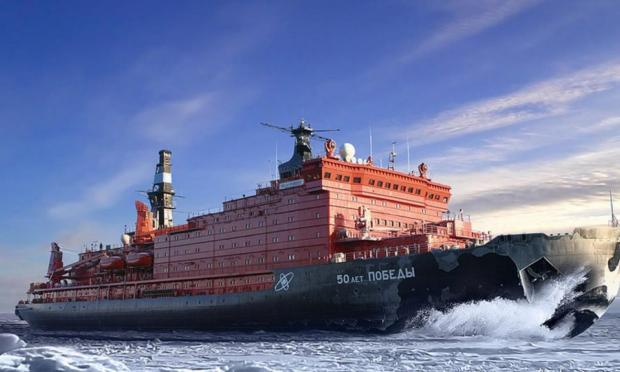It is well known that the US-Russia are fighting in the Arctic for the exploitation of its rich subsoil, but also for the dominance of navigation in the northernmost sea corridor of the planet, both for commercial and military purposes.
The importance of the Arctic and Russian plans
Central to this effort is the role of icebreakers, where Russia appears to be dominating thanks to its new generation of nuclear icebreakers.
For both Moscow and Washington, the development of the Northern Sea Route as one of the most important logistics corridors is a strategic priority, especially for the former since the Americans dominate the other sea routes thanks to their huge fleet.
For Russia in particular, increasing traffic is of paramount importance for fulfilling the tasks set in the field of the overall development of the Russian Arctic.
The development of this corridor is focused on the organisation of freight shipping on a regular basis, the construction of new nuclear icebreakers and the modernisation of the relevant infrastructure.
The new generation of Russian nuclear icebreakers
According to a reputable international media outlet, "Russia's Rosatom has completed production of RITM-200 reactors for a series of general-purpose nuclear icebreakers," which notes:
"Rosatom's Mechanical Engineering Department's manufacturing facility in Podolsk has completed the construction of the second RITM-200 reactor intended for the new-generation "Chukotka" icebreaker.
This is the last reactor to be built by the company under the current contract for the supply of power units for the new generation nuclear ships. After being prepared for transport, the reactor will be delivered to the Baltic plant.
Thus, the companies in the division are in effect playing the role of a 'transport zone' building ship reactors for the new generation of Russian icebreakers, whereas no other company in the world has similar experience.
"The RITM-200 reactors have proven their worth on the new Russian nuclear icebreakers, which has made sailing in the Northern Sea Route easier.
Similar reactors will also be installed on the fifth and sixth series of general-purpose nuclear icebreakers to be built in accordance with the decision already taken by the Government of the Russian Federation.
Production and supply of electricity from nuclear icebreakers to Russian ground-based "stations" in the Arctic
In the future, these reactors will be the "heart" of floating nuclear power plants, supplying energy to the Baimsk ore zone in Chukotka, as well as the onshore nuclear power plant in Yakutia," said Alexey Likhachev, Director General of Rosatom.
"RITM-200 is the most modern ship reactor unit with the highest performance in the world. Several companies of the Mechanical Engineering Division participated in the process of its creation.
As a result, the icebreakers have higher speed and ice-breaking capacity, which are important features for ships given the increasing cargo traffic.
Background
Afrikantov OKBM, JSC, is the designer, full supplier and manufacturer of the internal components of the RITM-200 reactor unit. ZIO-Podolsk, JSC, is responsible for the construction and test assembly of reactor vessels.
The power units intended for global nuclear icebreakers consist of two RITM-200 reactors of 175 MW each. The first of the two RITM-200 reactors to be installed on the Chukotka icebreaker had already been delivered to the yard at the end of October.
In total, since 2012, the company has built 10 reactors for the Arktika, Sibir, Ural, Yakutia and Chukotka nuclear icebreakers.
The first three have already been commissioned and are successfully fulfilling their duties by escorting convoys of ships in the western Arctic.
Construction projects for various modifications of RITM-type reactors are under way, which will be used not only as power units in icebreakers, but also to ensure the operation of small land-based and floating nuclear power plants.
The Chukotka icebreaker with a capacity of 60 MW is the fourth serial global nuclear icebreaker of the 22220 project being built under Rosatom's order at the Baltic plant in St. Petersburg.
It is to be commissioned in 2026. The nuclear icebreaker will operate in the western part of the Arctic, including the Barents, Pechora and Kara Seas, as well as in its shallower waters in the Yenisei "mouth" and the Ob Bay region.
The importance of Russian icebreakers in the Arctic
The 60 MW Project 22220 nuclear icebreakers are currently the largest and most powerful in the world.
Each icebreaker is equipped with two RITM-200 reactors. The icebreakers are 173.3 m long, 34 m wide and 33.5 thousand tonnes in displacement.
These icebreakers will be able to drive "ship caravans" in Arctic conditions, breaking through ice up to three metres thick.
Their main task is to ensure year-round navigation in the Western Arctic region.
The Russian triptych of Arctic domination
Following the above, it can be understood that Moscow, based on "the triptych" of organising freight shipping on an annual basis, building new nuclear icebreakers and modernising the existing infrastructure in this icy region of the world, is attempting to get the upper hand over the US-West, both in relation to the exploitation of the rich hydrocarbon-ore deposits and maritime transport.




